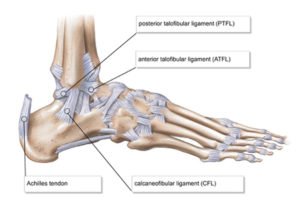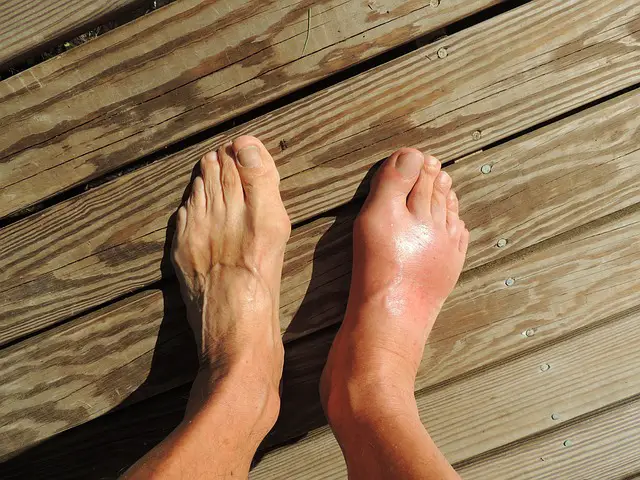Kelsey Downing, PT, DPT
 An ankle sprain; odds are you have probably experienced one at some point in your life. In the United States, a reported 25,000 people have sprained their ankles. While many ankle sprains occur with sports, some of these ankle injuries occur during non-sporting activities. Ankle sprains can occur during a daily routine to anyone at any age. While ankle sprains do eventually heal, they can still result in lifelong issues with pain, instability, and weakness. So, if you are living an active lifestyle it would be beneficial to add some exercises to your routine to increase your ankle stability and decrease your chances of ankle sprains in your future.
An ankle sprain; odds are you have probably experienced one at some point in your life. In the United States, a reported 25,000 people have sprained their ankles. While many ankle sprains occur with sports, some of these ankle injuries occur during non-sporting activities. Ankle sprains can occur during a daily routine to anyone at any age. While ankle sprains do eventually heal, they can still result in lifelong issues with pain, instability, and weakness. So, if you are living an active lifestyle it would be beneficial to add some exercises to your routine to increase your ankle stability and decrease your chances of ankle sprains in your future.
What is an Ankle Sprain?
 An ankle sprain is an injury that occurs when you step on or put weight on a foot that is plantarflexed on an unstable surface. This position causes the ankle “roll” inward and results in stretched or even torn ligaments on the outside of the ankle. There are different severities of the injury with some being minor and needing a few days to heal while the most severe grade 3 injuries may take up to 2 years at the longest to completely heal.
An ankle sprain is an injury that occurs when you step on or put weight on a foot that is plantarflexed on an unstable surface. This position causes the ankle “roll” inward and results in stretched or even torn ligaments on the outside of the ankle. There are different severities of the injury with some being minor and needing a few days to heal while the most severe grade 3 injuries may take up to 2 years at the longest to completely heal.
Grades of Ankle Sprain
Grade 1: A slight stretching or small micro-tears within the ligaments of the ankle. The most commonly injured ligament is the Anterior TaloFibular Ligament(ATFL). These usually heal within a week or two, have mild swelling, but rarely cause long term issues if treated appropriately.
Grade 2: This injury is more involved and may result in greater tearing of the ATFL as well as the Calcanealfibular Ligament(CFL) on the lateral side of the ankle. This does cause more swelling that could benefit from a compression sleeve, you may be limping for a week or two, and may take a few months to completely heal.
Grade 3: The most severe of the ankle sprains, at this level there is substantial damage to the ligaments of the ankle. This usually means there is a complete tearing of the ATFL and/or the CFL ligament. There is usually severe pain and swelling. Walking is difficult and you will likely need a walking boot and crutches to properly move around. This may require surgery for a long term solution but considerable focus on care will be needed for a full recovery.
Why It’s So Important to Prevent an Ankle Sprain
Preventing is much better than recovering, right? Especially with ankle sprains as once you have one, your chances of it happening again increase considerably.
The single best predictor of a future ankle sprain is already having had one in the first place.
Each time you re-sprain your ankle, it is more likely to be more severe and take longer to recover from. The key is to prevent it from happening again. The stronger and more stable you can make your ankle, the less likely you are to roll it again.
Exercises to Reduce your Risk of Ankle Sprains
Heel Raises
For this exercise, stand with your feet hip-width apart. Start to shift your weight onto your toes, slowly lifting your heels off the ground. Try to keep a neutral position of the ankle, not allowing them to roll out. As you return your heels back to the ground control the movement for improved muscle engagement, meaning GO SLOW. Complete 20 of these emphasizing the control of the movement. We like to do it off a step to make it harder, our favorite is the Original Step on Amazon.
Single Leg Stance
This not only strengthens your ankles but also works on your balance and proprioception which help in preventing ankle injuries. For this exercise start standing with the feet hip-width apart. Start to lift one foot off the ground, bending the knee slightly, coming into a single leg stance. Try to hold this position for 20-30 seconds then repeat on the other side. With the exercise, you may shake and sway and that is completely normal, just try to avoid leaning the trunk as compensation for balance. Do 2-3 times on each leg. To make it harder you can try to balance on a Bosu ball on either on the blue side up or black side up.
Single-Leg RDL
For this exercise, you should be standing on a hard surface or on a foam balance pad. This exercise works on all of the muscles of the leg. Start by balancing on one leg with a slight bend in the stance leg. Slowly tip forward bringing the trunk down to the floor while keeping the leg straight. Return back to a standing position without putting the other foot back down maintaining a balance. To make it harder we recommend balancing barefoot on a foam pad.
Ankle Bounces
This is a plyometric exercise that is commonly used as a warm-up activity in athletes. This exercise is great for strengthening the muscles of the lower extremities and is a way to work on controlling dynamic movement in the ankle. For this exercise start with your legs hip-width apart, start to bend your knees slightly, and jump up. Try to land on the balls of your feet and control the movements back down to the ground. Continue this movement at a moderate pace for 1-2 minutes.
Ankle Mobility with Resistance Band
For this exercise sit on the ground, or firm surface, and have a medium-strength resistance band secured to a sturdy anchor. For this exercise, you will work on strength in all of the planes of ankle movements. Try 20 times for each of these exercises.
- Dorsiflexion: put the band around the forefoot and point the toes towards going into the resistance.
- Plantarflexion: continue with the band around the forefoot, point the toes away from with going into the resistance.
- Inversion: the band around the forefoot, roll the big toe side of the foot inwards towards the resistance. With this movement try not to compensate with the movement of the upper leg.
- Eversion: the band still around the forefoot, roll the small toe side of the foot outwards towards the resistance. Again try not to compensate.
Other Helpful Tips to Prevent Ankle Sprains
Ankle Braces/Taping
Ankle Braces or taping techniques can be used during physical activity to help support the ankle and decrease the risk of injury. These techniques firmly hold your ankle in place and decrease the risk of rocking side to side and give steadiness to the ankle. We have an excellent article on the best braces for ankle sprains.
Warm-Up
To decrease the risk of ankle sprains it’s important to add a gentle stretching routine to your pre-exercise routine. By warming up the muscles before your activity you can decrease the risk of injury.
Shoe Wear
Look into getting shoes that are specific to your feet and your sport. If you have a high arch, find shoes with arch support. A soccer player, try wearing cleats for improved traction on the field. The more specific the shoe to you and your sport the better off you will be.
References
“Preventing ankle sprains.” Williams College. May 2019. https://health.williams.edu/medical-diagnoses/general-health-concerns/preventing-ankle-sprains/
“Ankle sprain prevention: what works?” January 2019. https://thesportsinstitute.com/ankle-sprain-prevention-what-works/
“Sprained ankle: rehabilitation.” The University of Michigan Medicine. August 2017. https://www.uofmhealth.org/health-library/te7604
Written By: Kelsey Downing, DPT
Kelsey Downing earned her Doctor of Physical Therapy (DPT) degree in 2016 from Campbell University in Buies Creek, NC. Since then, she has been working in a variety of settings. From outpatient, acute care, and home health she has gained a wealth of hands-on knowledge. Additionally, she has sought out further certification in manual therapy, concussion management, and lymphedema management. She continues to be driven to learn and refine her skills to improve patient care.
Disclaimer: The information provided in this post is for educational purposes only. This is not a substitute for a medical appointment. Please refer to your physician before starting any exercise program.






